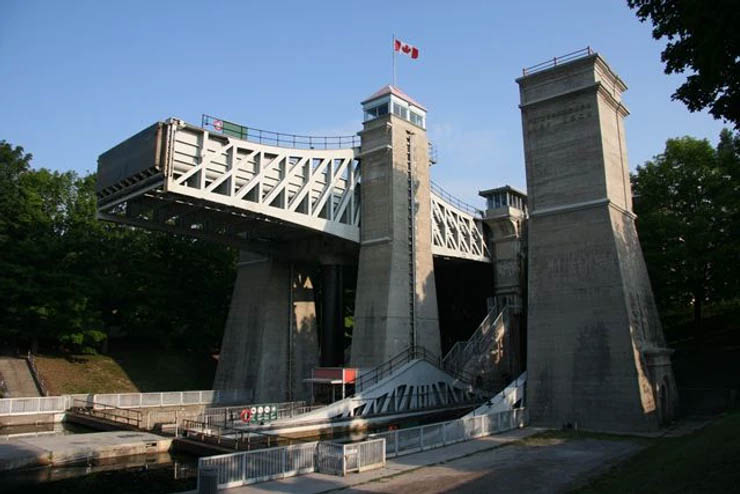Whether you’re a Looper or a local, the Peterborough Lift Lock grabs your attention.
It is the world’s highest hydraulic lift lock, the first built in North America (the second was the Kirkfield Lift Lock also on the Trent-Severn Waterway), and an engineering marvel that operates on the same principles using mostly original parts more than 100 years later.
Back in the late 1800s, Superintendent R.B. Rogers, was looking at the 65-foot lift required in Peterborough. The obvious solution would have been a series of flight locks but, as anyone who has transited the Welland Canal or Rideau Canal’s flight locks in Ottawa can tell you, that is not a fast process.
Instead, after investigating locks in Europe, he devised what still stands today. A 19.8-metre (65-foot) single lift on gigantic rams floating in water.
Built from 1896 to 1904, the construction was complex but the concept was wildly straightforward.
“Local hands built this thing and thought of it,” says Parks Canada’s Manager of Canal Operations, Chad Buchner. “While us local people in Peterborough find such a pride and a passion in this, now people from around the world to experience this structure.”
Buchner explained that a traditional flight lock system would have taken around three hours to transit this height. The hydraulic lift takes 90-seconds from start-to-finish once the process begins.
Of course it takes longer than that as you slowly inch into the basins – especially if you are downbound and are inching up to a 65-foot drop!
“The basic operating principle on this is the upper chamber has an extra foot of water in it. That adds 144 additional tons to the weight of it,” Buchner explained as we stood in the shadows of the lock. “The chambers themselves are balancing and floating in water. It’s really the world’s largest teeter-totter.”
Going between the two chambers of water, beneath the giant rams that hold each basin up, is a 30-centimetre (12-inch) crossover pipe with a valve that gets open and shut to allow the transfer of water from one side to another
Designed to not use any electricity, the tower in the middle with the red roof and flag on top that now serves largely as decoration was the original lockmaster’s position when the crossover valve was opened-and-closed by a pulley system.
Open the valve and the extra 144-tons of water in the upper chamber uses gravity to drop itself down. But water can only move so fast through a constrained opening so the drop is throttled by the flow of the water through that crossover pipe.
It doesn’t matter how many boats are in the chamber because the laws of Archimedes’ principle of buoyancy. If you forget your science lessons, suffice it to say that anything that floats – which should include your boat! – will displace it’s own weight in water.
In other words, if you had a boat that weighed 144-tons and cruised that into the upper basin, it would weight the exact same as if it was empty. Same with the lower one. It will always be lighter which means it will always lose the battle against gravity when the water from the heavier/upper side is forced over to underneath its ram.
Designed not to use electricity, things were upgraded in the 1970s after one of the gates gave way and water – and a boat – flowed off the side. The driver of the boat amazingly suffered only minor injuries I’m told but the decision to upgrade the gates to hydraulics was made.
The only electricity the entire operation uses to this day is for the control panel for the automatic gates, navigation lights and signage. The lock itself still operates using water, gravity and a limited-size-crossover valve to throttle the flow.
Genius.

I was granted exclusive access underneath the lock and inside the massive concrete structure. It’s cool and there is some moisture here and there, but mostly it’s like a big empty tomb.
Within the main wall there is a pump that was added in modern times. “These pumps force the water from the upstream side to underneath where we have an accumulator value,” Buchner explained. “That will always ensure we have the perfect balance of water holding our chambers in the air.”
Sure it’s another element – like the hydraulic gates – that is not original, but I’ll take modern safety redundancies on an old machine any day!
The Trent-Severn Waterway is an Ontarian’s playground with thousands of cottages and homes dotted along the lakes and rivers that make up the 386 km (240 miles) total route. It’s also a highlight for anyone doing the Great Loop, the circumnavigation of North America’s eastern seaboard, but more than all of that this is a testament to local ingenuity.
Peterborough-designed, Peterborough-built, and still a Peterborough Landmark. I’m even told that the gravesite of R.B. Rogers, the genius behind the design, is angled differently than the rest in the local cemetery so that his tombstone faces his legacy.




